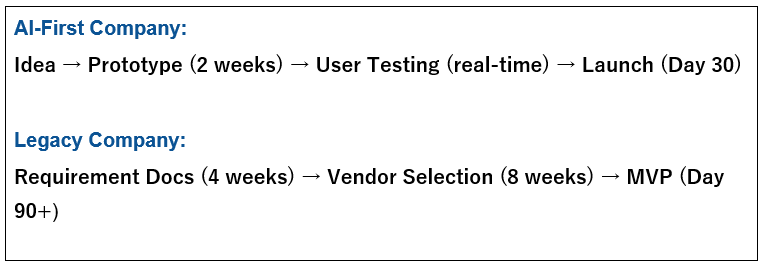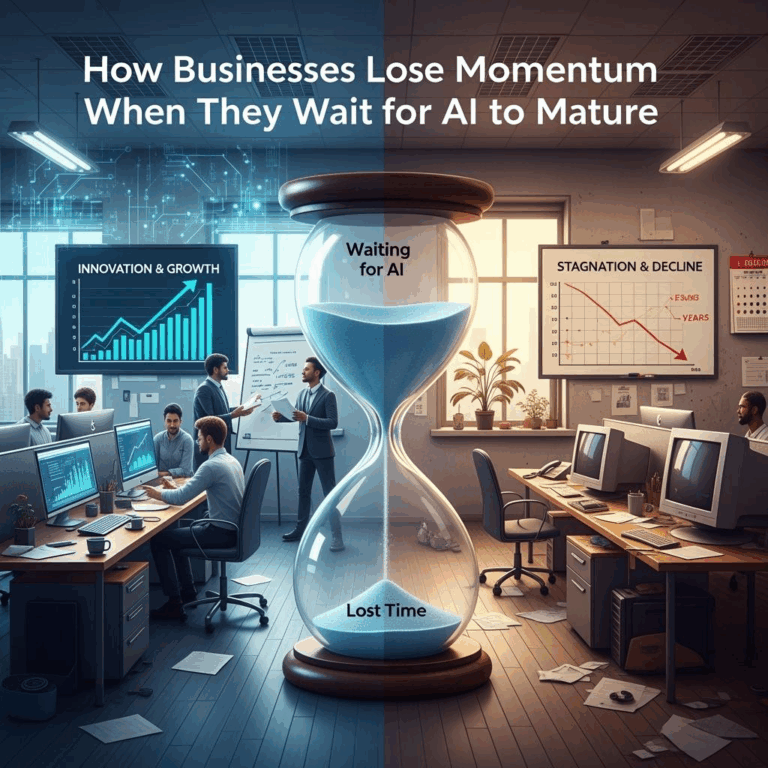AI is not just transforming industries; it is also transforming the way we compete. What used to be a luxury is now table stakes, forcing efficiency, innovation, and customer interactivity.
It’s no longer, “Should we use AI?” but “How fast can we move it into our core strategy?
AI is now a survival tool. Financial services, healthcare, retail companies, and manufacturers use it to forecast trends, automate processes, and personalize experiences. Those who wait for AI to “mature” will face an increasingly compounding disadvantage in terms of cost, speed, and capability compared to early adopters.
Large companies today feel they are under pressure to deploy AI in order to remain competitive. That’s not just data – it’s a warning. The chasm between the early and late adopters is growing wide.
Hesitation isn’t caution, it’s risk. Waiting for AI to grow up is like waiting for the train you missed. Early adoption is not a choice; it’s the only way you can lead, stay relevant, or succeed in the age of AI.
The Real Cost of Waiting on AI Adoption
Deciding to wait to adopt AI is not a neutral action; it’s a strategic mistake with deep, often permanent implications. And with AI penetrating all aspects of industry and society, the costs of inaction are rising exponentially.
The following are the five key risks encountered by companies that move too slowly.
A) Missed Compounding Advantage
Adopting AI is like a compound interest investment – the earlier you make it, the bigger the payout. This is true not just for the technology but also for the ecosystems that are developed by early adopters around it.
Early Advantage: Businesses that are early adopter of AI have the time to create strong data infrastructures and feedback loops, as they work over time, which means their system would never stop improving. AI feeds on data, and the longer a model works in the wild, the more refined and effective it becomes. This generates a flywheel effect, in which early adopters are disproportionately rewarded as time goes on.
Institutional Knowledge: Early AI adopters have the opportunity to build institutional knowledge and ways of working that are hard for laggards to duplicate. These “learning curves” are not purely technical — they’re cultural and operational shifts that require years to embed.
Example: Multimodal AI systems like OpenAI’s GPT models connected to computer vision improve far more due to real-world applications. Early users of this sort of system in, say, customer support or content generation, build proprietary data sets and workflows that the later entrants can’t easily copy, which only increases the divide.
The result? Following industries continually lag, even as they try to catch up with the productivity, creativity, and wisdom of leading-edge industries.
B) Efficiency & Margin Erosion: The Profitability Trap
As early movers leverage AI to re-engineer their cost structures, laggards are forced to work on a legacy platform that is less efficient and, ultimately, detrimental to their bottom line. AI-first businesses are saving tens of millions of dollars in core operational functions, such as support, finance, and procurement.
This is not just tooling for repetitive tasks. It’s about systemic optimization
Customer Support: AI co-pilots are delivering real-time answers to agents, shortening call handling time by 30-50% and raising first-call resolution.
Finance: AI models forecast instead of reporting on history, optimize cash flow, catch fraud with pinpoint accuracy, and automate complex reconciliations.
Procurement: Supplier contracts are reviewed by AI, potential cost-saving initiatives are determined, and negotiation simulations are employed to achieve better terms.
The risk for laggards: With each day a company waits, it is effectively deciding to pay more in operational expenses. This is an immediate margin-erosion process and forces a choice: increase prices and become uncompetitive, or swallow the costs and lose margins. The result is a vicious cycle, in which the laggard not only has less to spend on the very innovation AI that could save it, but its AI-empowered competitors go on to re-invest their efficiency gains into stretching the gap further.
C) Talent Deficit Creation
The battle for AI talent is as fierce as it is revolutionary. Companies that don’t embrace AI face not only the ire of their customers but also a revolt by the workers.
Data scientists, machine learning engineers and product managers like to work for companies that value innovation. These professionals are attracted to places where they can work and do exciting things with very real impact.
Organizations without AI projects find it hard to recruit and hold onto talent. High performers depart for more interesting work at the competition, and laggards end up holding an empty bag.
Above and beyond technical functions, the non-adoption of AI has an impact on corporate culture. Employees in all departments are expecting tools that will make them more productive and less miserable (whether it’s AI-powered analytics for marketers or recommendation engines for sales teams). Without these tools, firms risk losing not just technical personnel but all employees who desire more agile workplaces.
This talent exodus multiplies over time because innovative companies are creating strong teams while laggards encounter recruitment crises.
D) Product Velocity Gap Widening
AI is changing the rate at which companies can innovate, iterate, and create customer value. Companies that integrate AI in product development pipelines consistently outperform those that don’t.
AI-first startups have come to market with dramatically shorter product development cycles. Machine learning algorithms can more quickly digest the user feedback and recognize the market demands as well as areas of improvement more rapidly than classical methods.

For example,
- In gaming, AI makes real-time personalization possible, boosting gamer engagement and retention.
In customer service, for example, AI automated chatbots offering solutions for the customers on the spot result in users and consumers having higher satisfaction levels.
Within onboarding, AI is transforming repetitive tasks through automation to produce frictionless experiences.
As AI-first companies perpetually reinvent themselves, non-adopters are left behind. Their products/services rapidly become obsolete, resulting in attrition of your customers and erosion of their market share.
This “product velocity gap” is why AI-first companies have an enduring competitive advantage in innovation and CX.
E) Competitive Position Risk
AI itself is no longer a differentiator; it’s increasingly a baseline expectation. Businesses lagging in adoption can risk appearing irrelevant in their markets.
Situation: Competitors using AI scale more rapidly, deliver better services, and claim market shares faster than ever before. For instance, AI-integrated logistics companies such as Flexport refine global supply chains and enable clients to decrease shipping expenses as well as enhance delivery schedules. There are no competitors who can perform as efficiently without the power of AI.
RFP Inclusion: AI capabilities are becoming part of standard requests in client and partner proposals. Companies that can’t prove they are fluent in AI are getting left behind on big deals.
The result? A vicious cycle is then created in which low revenue, lost contracts, and reduced market share make regeneration nearly impossible.

The Myth of “Waiting for the Right Time”
The misconception that there’s a “right time” to integrate AI is one of false logic, based on passing ideas about when technology becomes mature enough for broad adoption. AI as a category is never done- it’s a system that constantly learns and evolves the more it is used in the world. The prudent thing is not to wait for AI to become perfect (or a god). And organizations must accept that, as with other technologies, iterative adoption – rolling out AI in digestible chunks, learning through its inevitable flaws, and improving along the way – is the only feasible path to mastery.
Look at Amazon’s recommendation engine; it started as a simple pattern-matching system and then, through years of iteration and data-gathering, became a predictive hypermachine. The lesson here is that perfection comes from experience, not reluctance.
History supports this, as the cloud computing revolution proved. Early cloud adopters like Netflix and Salesforce benefited from incredible levels of scale and agility, while latecomers struggled to graft on up-to-date infrastructure at highly inflated prices. AI is on the same path. Early adopters are deeply embedding AI into their operations, realizing compounding benefits in data, processes, and talent that latecomers can’t easily replicate.
For example, Tesla’s autonomous driving AI feeds on billions of miles of in-house real-world data that give it an insurmountable lead over rivals attempting to enter the space today. The longer an organization hesitates, the larger these gaps become, and competitive parity becomes impossible.
One reason commonly given for putting off action on regulatory concerns is equally misguided. Compliance and ethical considerations are not impediments to making people’s lives difficult, but they are opportunities to establish trust and resilience from the onset. Early adopters have the opportunity to bake in regulatory requirements such as GDPR or HIPAA into their AI strategy and make it a differentiator.
For the healthcare industry, using the NIST AI Risk Management Framework, this approach enables companies to develop systems that meet regulations from Day 1, helping to further reduce time and risk in approval. This process is further streamlined by working with companies specializing in ethical AI deployment, which provides radical transparency, security, and scalability.
Kicking the can down the road to avoid compliance headaches will only make it cost more when you have to re-integrate systems in such a way that maintains pace with your competitors and what is deemed as the best practices within the industry.
The Widening Gap: What Delaying AI Feels Like (6 Months from Now)
Slowing the adoption of AI is not a neutral act: It is a compounding disadvantage that becomes staggeringly evident within months. Pressure on boards to adopt AI plans mounts as directors and investors seek a definitive strategy for staying competitive. When peers are able to explain how AI is boosting efficiency, innovation, and customer satisfaction, leadership with no map finds itself in a difficult position to defend its inertia. This lack of leadership will cause doubts, within and outside the system, making it look like its leaders are standing still.
Meanwhile, rivals who deploy AI-driven features first are stealing a march in areas that matter to customer adoption and market share. In municipal services, for instance, AI-powered routing systems enable even closer connectivity to citizens who need a fast response and efficient resource allocation: Non-users seem stuck in the past.
The most innovative companies are responding to this challenge by creating experiences that anticipate how business customers want to work. Customers will naturally gravitate toward those businesses that provide faster, smarter, and more personalized experiences, increasing the gap between leaders and laggards.
To put this in perspective, without any clear AI strategy at the enterprise level, employees are using non-approved AI tools (whether out-of-the-box chatbots or data analysis platforms) to meet productivity. It’s a nice try, but that is totally unacceptable from a security point of view, as well as exposing unnecessary data and inconsistent workflows. The proliferation of these types of “shadow AI” negatively impacts operational consistency and raises compliance exposure, which drives leadership to be in a reactive firefighting mode rather than planning the future state proactively.
Visibly, it is the stagnation of platform use that is so apparent. Competitors that are early adopters of AI are stretching their resources, serving greater volumes of customers with fewer employees, while those yet to take the plunge struggle to scale.
For example, AI-powered customer-service systems simultaneously process thousands of requests, providing solutions as they are found in real time v/s. their non-AI counterparts that crumble under high demand. This efficiency gap is not only hurting the bottom line; it is shifting market share irrevocably.
Ultimately, AI becomes a compliance requirement in RFPs, and non-adopters are essentially blocked from high-value deals. “More and more clients are expecting AI-driven features such as predictive analytics, autoreporting, or live insights as default upon delivery. Proposals without AI aren’t merely at a disadvantage — they’re being disqualified. At the six-month point, the price of waiting isn’t theoretical anymore; it’s evident in lost deals, withered trust, and a growing set of inefficiencies.

What Leading Enterprises Are Doing Differently
As most companies struggle with how to incorporate AI into their business processes, the first-movers are getting ahead by charting a course of execution, scale, and competitive advantage. They begin with the high-leverage use-cases – ones that would offer very quick payback and line up well with their critical business imperatives.
AI agent copilots in customer service, for example, can halve response times and double precision. Similarly, internal search conversions knowledge management for the 21st century – organizations can put essential information in their workers’ hands instantly, so they don’t have to ask questions and wait for the answer.
Automated knowledge extraction tools put the right information in front of decision-makers, personalized and timely enough to shape strategy. This sharp focus on meaningful use cases for AI investment also ensures that the companies stand to generate a tangible return on their investment.
To implement these efforts, Top companies are forming dedicated AI task forces – cross-functional teams that span operations, product development, and decision-making—to drive these initiatives. The development team consists of mixed domain-technical AI experts with leadership alignment to ensure that AI is not forced into a silo but integrated within the design DNA itself. By bringing together data scientists, engineers, and business leaders to collaborate on projects at the cusp of the company’s strategic priorities, these task forces drive AI adoption that’s in line with the company’s strategic direction.
These companies understand that AI grows on robust infrastructure, and they are investing big in laying the foundation. This includes building scalable data pipelines to enable seamless data flow across the organization, establishing evaluation frameworks for AI track and trace, information governance, ethics, and compliance algorithms, as well as implementing feedback loops that will influence ongoing model development in real-time through the use of the product.
For instance, predictive capabilities for optimizing supply chains are enriched by feedback and operational data, in a virtuous circle of efficiency over time.
The other trait of leading firms is their focus on rapid piloting and iteration. Instead of waiting for the mythical moment when their AI will be perfect enough to ship, these companies release AIs quickly into the world, receive feedback, and work to improve performance.
UrbanChat Company is leading the way here with its chatbot strategy that has resulted in increased query resolution and customer satisfaction. Beginning with a bare-bones product and iterating by engaging with the real world, they outperformed competitors who stuck more closely to lengthier pre-launch development cycles.
Lastly, industry leaders are teaming up with independent experts to further expedite their AI-transformation process. With the help of bespoke firms or platforms, they they can reduce their internal workloads and can tap into state-of-the-art thinking.
For instance, an organization can engage in a partnership with an AI consultancy to speed up deployment while investing in its own teams so that they are self-sufficient over time. This hybrid approach gives you immediate time-to-value and is laying the foundation for more widespread, long-term AI adoption.

Seizing the AI Opportunity Before It’s Too Late
The race to embrace AI is accelerating rapidly, underscoring the real danger of falling behind: the division between AI leaders and laggards will only expand at an exponential pace.
Enterprises that do this now can embed AI in their operations, compounding the advantages of accelerating efficiency, customer experience, and even innovation.
Meanwhile, the laggards are in danger of becoming irrelevant as that gap between leaders and followers increases exponentially. The early AI adopters who are in the top 10% are already taking away more than 80% of market share driven by AI, so laggards are left with growing levels of operational inefficiency, falling market share, and declining access to talent with AI skills. The stark reality is that what may feel like a six-month delay today amounts to a competitive disadvantage measured in years.
The most successful companies realize that it’s agility, not perfection, that leads to success in AI. They begin with well-defined, high-value problems — for example, automating repetitive customer service tasks or optimizing supply chain logistics. They are small, but fast iterations that show ROI and then get scaled across the business.
But if scale fast is on your to-do list, you’ll first need a solid foundation: a scalable data infrastructure that makes it possible to integrate easy-to-use AI solutions and governance that shields against ethical risks and non-compliance, along with model drift.
For example, a retail organization could begin with demand forecasting driven by AI in a single region before scaling to the international level with a centralized data pipeline and transparent decision monitoring frameworks.
Initiatives along the lines of Tribe AI can help to accelerate this transition. They’re great at hunting down high-impact use cases, so that companies can focus their efforts on strategically rolling downhill on the right part of the value wheel, versus trying to attack everything everywhere from every front and getting too thin. They build tailored AI architectures that align with business needs, and the solutions they offer are pragmatic and scalable.
Tribe AI also specializes in fine-tuning models for various other business use cases, whether it’s predictive analytics in risk or generative AI for personalized marketing. A key is that they establish ethical frameworks for transparent, compliance-driven, and accountable use of AI from day one.
The result? Organizations release the full benefits of AI without compromise and risk – faster, driving enterprise growth with minimal disruption on their journey to AI benefits.
Conclusion
The price of waiting for AI cannot simply be tallied in lost opportunities, but also in the irreversible edge that it gives competitors who commit today. AI is more than simply a technology — it’s a powerhouse that is reshaping industries at hyper-scale.
Companies that delay are putting themselves into obsolescence as early adopters can use AI to improve and update products and services, even while keeping costs in check.
The time to jump on board is today, but not by hopping aboard – instead, integrate and build AI through your organisation’s core strategy.
The choice is stark: Help lead the change, or fall behind in a world that won’t pause while you get your act together.
Found this article interesting?
1. Follow Dr Andrée Bates LinkedIn Profile Now
Revolutionize your team’s AI solution vendor choice process and unlock unparalleled efficiency and save millions on poor AI vendor choices that are not meeting your needs! Stop wasting precious time sifting through countless vendors and gain instant access to a curated list of top-tier companies, expertly vetted by leading pharma AI experts.
Every year, we rigorously interview thousands of AI companies that tackle pharma challenges head-on. Our comprehensive evaluations cover whether the solution delivers what is needed, their client results, their AI sophistication, cost-benefit ratio, demos, and more. We provide an exclusive, dynamic database, updated weekly, brimming with the best AI vendors for every business unit and challenge. Plus, our cutting-edge AI technology makes searching it by business unit, challenge, vendors or demo videos and information a breeze.
- Discover vendors delivering out-of-the-box AI solutions tailored to your needs.
- Identify the best of the best effortlessly.
Anticipate results with confidence.
Transform your AI strategy with our expertly curated vendors that walk the talk, and stay ahead in the fast-paced world of pharma AI!
Get on the wait list to access this today. Click here.
4. Take our FREE AI for Pharma Assessment
This assessment will score your current leveraging of AI against industry best practice benchmarks, and you’ll receive a report outlining what 4 key areas you can improve on to be successful in transforming your organization or business unit.
Plus receive a free link to our webinar ‘AI in Pharma: Don’t be Left Behind’. Link to assessment here
5. Learn more about AI in Pharma in your own time
We have created an in-depth on-demand training about AI specifically for pharma that translate it into easy understanding of AI and how to apply it in all the different pharma business units — Click here to find out more.

